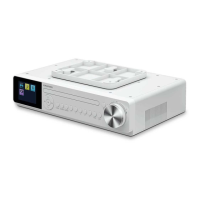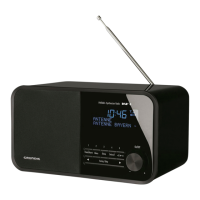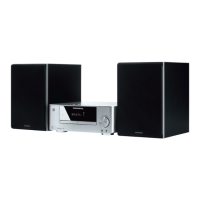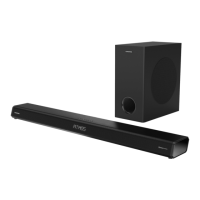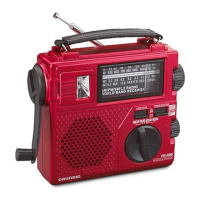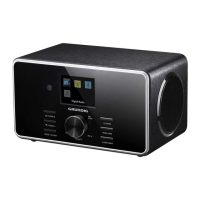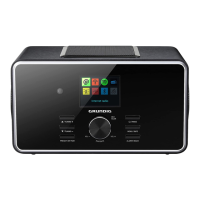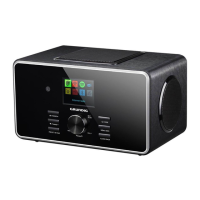Do you have a question about the Grundig 2100 and is the answer not in the manual?
Lists and describes all numbered controls, buttons, and sockets for operating the radio.
Details how to insert batteries or the accumulator into the bottom compartment.
Explains the correct position of the mains/battery switch for battery operation.
Explains how to read the meter to check battery status.
Advises on replacing batteries and important precautions.
Details how to connect the radio to AC mains power for operation.
Explains how to check and replace fuses during mains operation.
Describes how to select the correct mains voltage (110-127V or 220-240V).
Explains how to connect to a 9-16V DC source like a car battery.
Details automatic charging of the GRUNDIG Dryfit PC accumulator.
Explains how to switch the radio on and off using the power button.
Describes how to adjust the audio volume using the volume control.
Explains how to adjust bass and treble for desired sound quality.
Describes the tuning scales and indicator for AM and FM reception.
Explains how to select different wavebands using dedicated buttons.
Explains how to extend and position the telescopic and ferrite rod antennas.
Describes how to illuminate the scales and meter during battery operation.
Explains how to switch and tune the SW turret tuner across different ranges.
Lists frequencies for the bandspread SW ranges.
Explains how to connect and use an SSB adaptor for single sideband reception.
Explains using the tuning meter and automatic frequency control (AFC) for accurate tuning.
Describes selecting narrow or wide bandwidth for AM reception.
Explains how to adjust the aerial trimmer for optimal reception with external antennas.
Provides instructions for cleaning the radio's cabinet and scales.
Explains connecting record players or tape recorders for playback/recording.
Details connecting an external loudspeaker and its effect on the internal speaker.
Explains connecting earphones and its effect on the internal speaker.
Details connecting external aerials (FM, AM, car) and switching off internal ones.
Explains connecting the car aerial and using the car battery for power.
Notes the necessity of suppressing vehicle electrical system interference.
Lists power supply options and current/power consumption data.
Details the semiconductor components, fuses, and build of the radio.
Outlines licence requirements for installing and operating the receiver on ships.
Lists power supply options, battery life, and fuse specifications.
Details power modes (battery, mains, car) and their respective consumption.
Lists all wavebands and detailed frequency ranges for the SW tuner.
Details power supply, fuses, and semiconductor components.
Details circuit configurations, AGC, tone control, and loudspeaker types.
Lists power supply options, battery life, and scale illumination.
Lists and describes all numbered controls, buttons, and sockets for operating the radio.
Details how to insert batteries or the accumulator into the bottom compartment.
Explains the correct position of the mains/battery switch for battery operation.
Explains how to read the meter to check battery status.
Advises on replacing batteries and important precautions.
Details how to connect the radio to AC mains power for operation.
Explains how to check and replace fuses during mains operation.
Describes how to select the correct mains voltage (110-127V or 220-240V).
Explains how to connect to a 9-16V DC source like a car battery.
Details automatic charging of the GRUNDIG Dryfit PC accumulator.
Explains how to switch the radio on and off using the power button.
Describes how to adjust the audio volume using the volume control.
Explains how to adjust bass and treble for desired sound quality.
Describes the tuning scales and indicator for AM and FM reception.
Explains how to select different wavebands using dedicated buttons.
Explains how to extend and position the telescopic and ferrite rod antennas.
Describes how to illuminate the scales and meter during battery operation.
Explains how to switch and tune the SW turret tuner across different ranges.
Lists frequencies for the bandspread SW ranges.
Explains how to connect and use an SSB adaptor for single sideband reception.
Explains using the tuning meter and automatic frequency control (AFC) for accurate tuning.
Describes selecting narrow or wide bandwidth for AM reception.
Explains how to adjust the aerial trimmer for optimal reception with external antennas.
Provides instructions for cleaning the radio's cabinet and scales.
Explains connecting record players or tape recorders for playback/recording.
Details connecting an external loudspeaker and its effect on the internal speaker.
Explains connecting earphones and its effect on the internal speaker.
Details connecting external aerials (FM, AM, car) and switching off internal ones.
Explains connecting the car aerial and using the car battery for power.
Notes the necessity of suppressing vehicle electrical system interference.
Lists power supply options and current/power consumption data.
Details the semiconductor components, fuses, and build of the radio.
Outlines licence requirements for installing and operating the receiver on ships.
Lists power supply options, battery life, and fuse specifications.
Details power modes (battery, mains, car) and their respective consumption.
Lists all wavebands and detailed frequency ranges for the SW tuner.
Details power supply, fuses, and semiconductor components.
Details circuit configurations, AGC, tone control, and loudspeaker types.
Lists power supply options, battery life, and scale illumination.
| Type | Radio |
|---|---|
| Power type and voltage | 220V |
| Batteries | 4 x 1.5 Volt |
| Loudspeaker | Dynamic |
| Material | Plastic |
| Shape | Portable |
| Frequency Range | FM: 88-108 MHz, AM: 520-1620 kHz |
| Power Source | AC/DC, Batteries |

